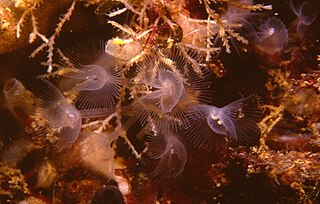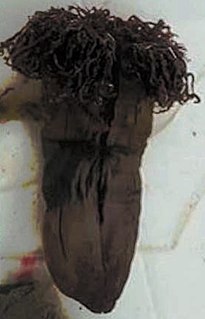
Bryozoa are a phylum of simple, aquatic invertebrate animals, nearly all living in sedentary colonies. Typically about 0.5 millimetres long, they have a special feeding structure called a lophophore, a "crown" of tentacles used for filter feeding. Most marine bryozoans live in tropical waters, but a few are found in oceanic trenches and polar waters. The bryozoans are classified as the marine bryozoans (Stenolaemata), freshwater bryozoans (Phylactolaemata), and mostly-marine bryozoans (Gymnolaemata), a few members of which prefer brackish water. 5,869 living species are known. One genus is solitary; all the rest are colonial.

Balanoglossus is an ocean-dwelling acorn worm (Enteropneusta) genus of zoological importance because, being a Hemichordate, it is an "evolutionary link" between invertebrates and vertebrates. Balanoglossus is a deuterostome, and resembles the Ascidians or sea squirts, in that it possesses branchial openings, or "gill slits". It has a notochord in the upper part of the body and has no nerve chord. It does have a stomochord, however, which is a gut chord within the collar. Their heads may be as small as per 2.5 mm (1/10 in) or as large as 5 mm (1/5 in).

Phoronis is one of the two genera of the horseshoe worm family (Phoronidae), in the phylum Phoronida. The body has two sections, each with its own coelom. There is a specialist feeding structure, the lophophore, which is an extension of the wall of the coelom and is surrounded by tentacles. The gut is U-shaped. The diagnostic feature that distinguishes this genus is the lack of epidermal invagination at the base of the lophophore. These worms are filter feeders. They live on hard substrates or soft sediments in marine environments throughout the world. They have different modes of reproduction which help with their success.

Nidamental glands are internal organs found in some elasmobranchs and certain molluscs, including cephalopods and gastropods.

Phoronids are a small phylum of marine animals that filter-feed with a lophophore, and build upright tubes of chitin to support and protect their soft bodies. They live in most of the oceans and seas, including the Arctic Ocean but excluding the Antarctic Ocean, and between the intertidal zone and about 400 meters down. Most adult phoronids are 2 cm long and about 1.5 mm wide, although the largest are 50 cm long.

Brachiopods, phylum Brachiopoda, are a phylum of trochozoan animals that have hard "valves" (shells) on the upper and lower surfaces, unlike the left and right arrangement in bivalve molluscs. Brachiopod valves are hinged at the rear end, while the front can be opened for feeding or closed for protection. Two major categories are traditionally recognized, articulate and inarticulate brachiopods. The word "articulate" is used to describe the tooth-and-groove structures of the valve-hinge which is present in the articulate group, and absent from the inarticulate group. This is the leading diagnostic skeletal feature, by which the two main groups can be readily distinguished as fossils. Articulate brachiopods have toothed hinges and simple, vertically-oriented opening and closing muscles. Conversely, inarticulate brachiopods have weak, untoothed hinges and a more complex system of vertical and oblique (diagonal) muscles used to keep the two valves aligned. In many brachiopods, a stalk-like pedicle projects from an opening near the hinge of one of the valves, known as the pedicle or ventral valve. The pedicle, when present, keeps the animal anchored to the seabed but clear of sediment which would obstruct the opening.

The Euctenidiacea, common name dorid nudibranchs, are a taxonomic suborder of sea snails or slugs, marine gastropod molluscs in the order Nudibranchia. Bouchet & Rocroi (2005) rejected the name Anthobranchia on the grounds that it also included Onchidium at the time of original publication. Doridina is equivalent and used in the latest classification.
Phoronopsis is a genus of horseshoe worm in the family Phoronidae, in the phylum Phoronida. The members of the genus live in tubes at the bottom of the sea.
Phoronis psammophila is a species of marine horseshoe worm in the phylum Phoronida. It lives in a tube projecting from the sea floor in shallow seas around the world.

Phoronis australis is a species of marine horseshoe worm in the phylum Phoronida. It is found in shallow warm-temperate and tropical waters in the eastern Atlantic Ocean and the Indo-Pacific region and was first detected in the Mediterranean Sea in the late twentieth century. These worms live in association with tube-dwelling anemones, particularly those in the genus Cerianthus.
Phoronis ovalis is a species of marine horseshoe worm in the phylum Phoronida. It is found in shallow waters in the northeastern Atlantic Ocean, the southeastern Atlantic Ocean, Argentina, and other scattered locations worldwide. These worms secrete a tube into which they can retreat, and burrow into the shells of molluscs.

Ceriantheomorphe brasiliensis is a species of tube-dwelling anemones in the family Cerianthidae. It is found in the tropical western Atlantic Ocean, the Caribbean Sea and the Gulf of Mexico. It is currently listed as endangered based on a lack of evidence.
Phoronis emigi is a species of marine horseshoe worm in the phylum Phoronida. It is found off the coast of Japan and is morphologically similar to Phoronis psammophila.
Phoronis hippocrepia is a species of marine horseshoe worm in the phylum Phoronida.
Phoronis ijimai is a species of marine horseshoe worm in the phylum Phoronida.
Phoronis muelleri is a species of marine horseshoe worm in the phylum Phoronida.
Phoronis pallida is a species of marine horseshoe worm in the phylum Phoronida.
Phoronis savinkini is a species of marine horseshoe worm in the phylum Phoronida. It is found in the Gulf of Tonkin. The holotype was collected off the coast of Vân Đồn District, Quang Ninh Province in northern Vietnam.
Phoronopsis harmeri is a species of marine horseshoe worm in the phylum Phoronida. It was first described by H.L.M. Pixell in 1912, and was found off of Vancouver Island.
Phoronopsis albomaculata is a species of marine horseshoe worm in the phylum Phoronida.








